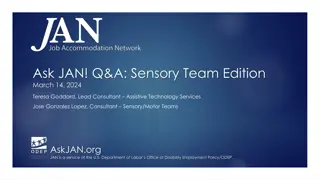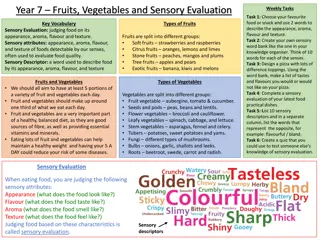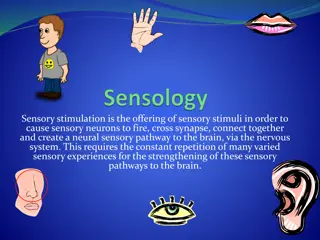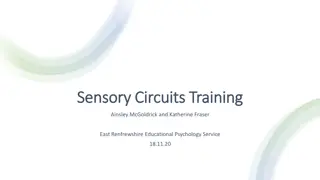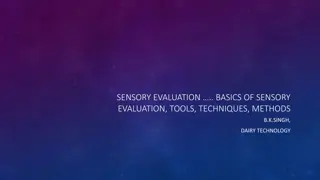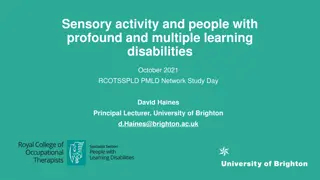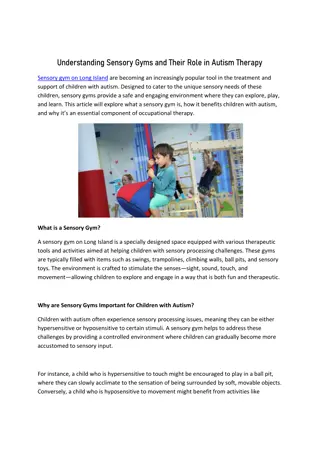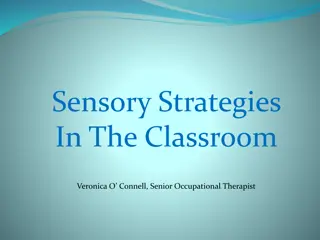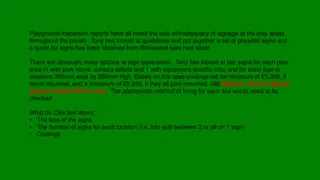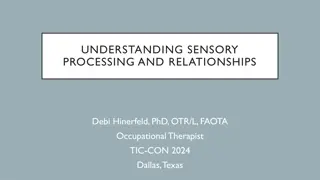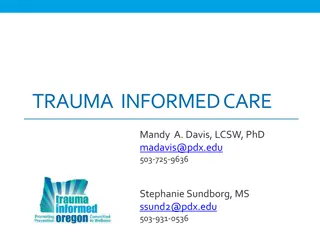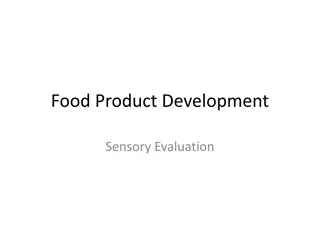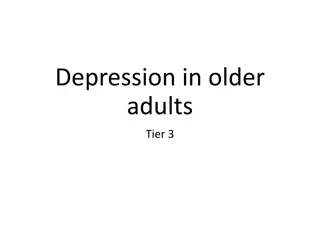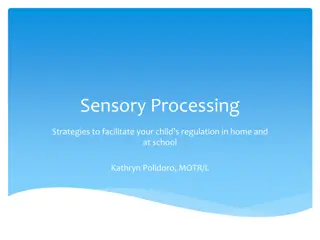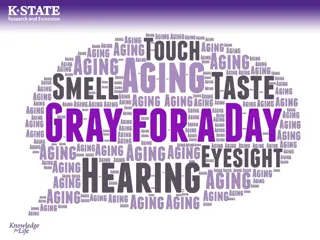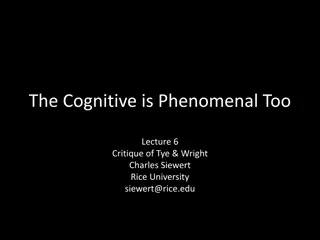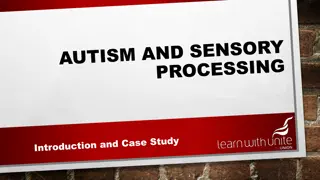Understanding Sensory Loss in Adults: Causes, Signs, and Impact
Sensory loss, including sight and hearing impairment, can affect individuals of any age. Causes range from trauma to genetic conditions, with indicators like changes in behavior or difficulty with communication. This loss can significantly impact daily life, communication, and social interactions. Recognizing the signs and understanding the impact can help support individuals with sensory loss effectively.
Download Presentation

Please find below an Image/Link to download the presentation.
The content on the website is provided AS IS for your information and personal use only. It may not be sold, licensed, or shared on other websites without obtaining consent from the author. Download presentation by click this link. If you encounter any issues during the download, it is possible that the publisher has removed the file from their server.
E N D
Presentation Transcript
003 Health and Well-being Adults CARLY PEMBREY
Sensory loss Sensory loss is when one of the senses, i.e. sight, hearing, smell, touch, taste, is not working as it should. The term is used primarily to describe sight loss, hearing loss and deafblindness. A sensory loss can affect individuals of any age. It may have been from birth or acquired at a later age. Sensory loss in the form of loss of sight or hearing affects many older people
Causes and conditions of sensory loss Examples of causes and conditions of sensory loss include: Trauma - An accident involving a head injury may impact on vision or hearing. Glaucoma - Damage to the optic nerve by pressure of fluid in the eye. Cataracts - Clouding of the lens in the eye leading to a loss of vision. Macular degeneration - Usually age related. Affects the middle part of vision. Can be linked to smoking, high blood pressure, being overweight and family history of macular degeneration. Diabetic retinopathy - A complication of diabetes caused by high blood sugars damaging the retina. Can cause blindness if left undiagnosed and untreated. Viral causes (i.e. meningitis). Hereditary conditions. Industrial and noise induced deafness. Meniere s disease - Disorder of the inner ear. Causes vertigo and hearing loss. Ageing - This is the largest cause of sensory loss. Premature birth. Viruses during pregnancy (e.g. rubella). Genetic conditions such as Usher syndrome - Usher syndrome is caused by gene mutation and the main symptoms are hearing loss and an eye condition called retinitis pigmentosa. Cerebral palsy - Many individuals with cerebral palsy also have sensory problems
Potential indicators and signs of sensory loss Sight loss: Indicators and signs of hearing loss: holding reading materials further away or nearer than usual not reacting to visual clues or signs sitting too close to the television bumping into or tripping over objects moving around slowly (using walls as a guide) not seeing nearby objects difficulty in determining floor level changes discomfort with changes between light and dark difficulty in seeing objects off to the side white areas on the pupil complaining of seeing bright flashes of light. failing to react to voices coming from behind difficulty following and joining a group conversation apparent inattention using an excessively loud voice continually asking individuals to repeat what they have said turning the television volume up failing to respond to the doorbell or the telephone giving inappropriate responses to questions/conversation complaining of not being able to hear when there is a lot of background noise feeling tired or stressed from having to concentrate while listening.
Factors that impact upon an individual with sensory loss Impact on communication Hearing loss can often be a hidden disability which can lead to problems with communicating with others and feelings of isolation for the individual concerned. They can struggle to use a telephone or hear the doorbell. This can make the individual feel frustrated. They can also find it difficult to watch TV or join in with group conversations, and this may cause them to withdraw into themselves. Individuals with sight loss are unable to recognise people and places, which can cause confusion and feelings of inadequacy and isolation. Impact on accessing information Individuals with sight loss will be unable to read timetables, menus, signs etc. Having to rely on another for this type of information can impact an individual s privacy and dignity. Similarly, an individual with hearing loss will struggle to access information that is not in print format and can feel a loss of privacy and dignity if not able to access their own information.
Factors that impact upon an individual with sensory loss Impact on routines Individuals who lose their sight will feel increasingly separated from the world around them as their brain receives less stimulation. They can also feel less secure and can tend to avoid going out, which can further exacerbate their sense of isolation. Individuals with hearing loss may withdraw from social routines as they struggle to cope with following conversations in noisy surroundings. Both sight and hearing loss can affect an individual s mobility as they feel less able to move around their local area safely. Impact on attitudes - Individuals with sight or hearing loss can feel that society begins to treat them differently. Individuals with hearing loss feel that those around them stop including them in conversations and talk over them. The thoughtlessness of others can put individuals with sensory loss in harm s way. Hazards such as cars parked on pavements can cause risk of injury to individuals with sight loss as they will be expecting the pavement to be clear.
Considerations when communicating with an individual with: sight loss; hearing loss; deafblindness Considerations when communicating with an individual with sight loss: allow extra time stand in a place where you can be seen and touch for attention if necessary always identify yourself use names to identify individuals tell the individual you are leaving them or if others are entering or leaving the room don t just walk away don t use non-verbal communication, such as pointing when communicating in writing, use large printed words rather than joined up writing provide information in different formats, e.g. email, large fonts, braille, audio tapes.
Considerations when communicating with an individual with: sight loss; hearing loss; deafblindness Considerations when communicating with an individual with hearing loss: allow extra time face the individual you are speaking to do not shout as this distorts the voice and lip patterns speak a little more slowly than usual stay in their field of vision use a loop system find out about their communication methods, e.g. sign language use finger spelling / sign language speak at ear level repeat/rephrase if needed write things down make sure there is no echo in the room ask individuals to repeat important information back to you to make sure it has been understood make sure hearing aids are switched on and functioning
Considerations when communicating with an individual with: sight loss; hearing loss; deafblindness Considerations when communicating with an individual with deafblindness: good lighting plain background stand in front of them individuals with deafblindness may communicate using: tactile communication using touch with objects tactual communication using touch with individuals use clear speech and clear print it might be useful to look at the Deafblind Manual Alphabet to communicate use specialist communication support.
The importance of supporting individuals to use aids, such as hearing aids, and glasses Some individuals are reluctant or embarrassed to use aids, such as glasses and hearing aids, because they see them as a sign of disability or ageing. It is important that individuals are supported to use available aids to maximise remaining sight and hearing, and enable them to manage in different environments. Wearing hearing aids and glasses support an individual's independence, which in turn gives them dignity, positive self-esteem and a greater sense of well- being.
The considerations when supporting an individual with loss of taste, smell or touch Mouth with tongue out Taste Loss of taste (hypogeusia) may be a result of health disorders, medication or an age-related decrease in taste buds on the tongue. A loss of taste makes it more difficult to eat a balanced and nutritious diet. Loss of the experience of enjoying meals affects social interaction and can lead to depression. A nutritionist can create a menu or eating plan to help overcome the loss of the sense of taste and smell with different tastes and textures.
The considerations when supporting an individual with loss of taste, smell or touch Smell Loss of smell (anosmia) can be caused by infection, changes in the brain or ageing. Loss of smell also decreases an individual s appetite and makes it harder to notice hazards such as fire, gas leak or out of date/spoiled foods. Smell ensures an individual maintains personal hygiene, but they may need additional support with this. For many, smell helps to evoke memories. Smoke and gas alarms enhance safety for those with a diminished sense of smell. Touch A reduced sense of touch (hypoesthesia) is a result of illnesses and diseases reducing blood flow to nerve endings. This makes it more difficult to detect pressure, temperature and texture, and in turn increases risks of falling and burns. Overall healthcare is important to individuals with no sense of touch as they may not feel injuries. Good footcare is important to those with a reduced sense of touch to stop the spread of infection. Care needs to be taken around hot objects/heat
Support available for individuals with sensory loss Centre of Excellence for Sensory Impairment (coesi)http://www.coesi.org.uk/Home.aspx Hearing loss Action on Hearing Loss https://www.actiononhearingloss.org.uk Wales Council for Deaf People http://www.wcdeaf.org.uk Hearing link Wales https://www.hearinglink.org/connect/hearing-link-wales Sight loss RNiB Cymru https://www.rnib.org.uk/wales-cymru-1 Welsh language text to speech software. Sight Cymru http://sightcymru.org.uk/ technology assistance befriending and telephone support. Guide dogs Cymru https://www.guidedogs.org.uk/guide-dogs-cymru/ Wales Council for the Blind http://www.wcb-ccd.org.uk/perspectif/index.php Deafblind Deafblind Cymru https://deafblind.org.uk/about-us/deafblind-cymru/

 undefined
undefined









